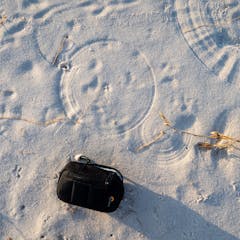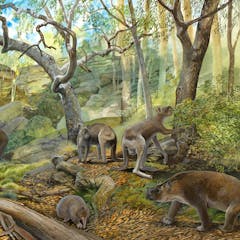
Articles on Fossils
Displaying 1 - 20 of 397 articles

New insect treasures are almost certainly just waiting to be found by future palaeonentomologists.

A 500-million-year-old find reveals previously unknown features of the sea creatures responsible for some of palaeontology’s most recognisable fossils.

A photo of Lucy’s reconstructed skeleton next to a live four-year-old girl shows how human Lucy was – and how small.

In 2021 a former avocado farmer discovered the most complete pterosaur skeleton ever found in Australia – and new research shows it represents a previously unknown species.

A recent find of an ancient giant bird’s skull has revealed much about its life among the vanished lakes and wetlands of inland South Australia.

Fossilized skin belonging to an amniote was recently discovered. The skin was so well-preserved, that its cellular structures could be identified.

Understanding more about feathers could change the way we think about dinosaurs.

Starfish reproduce by splitting in two. A new fossil reveals how ancient this ability is.

Such massive disruptions have in the past been caused by volcanoes or meteorites. Only humans have done this with full awareness of their actions.

There appear to be two possible explanations for circular patterns with central depressions in Pleistocene deposits on the Cape coast.

Finding and retrieving the bones of this extinct kangaroo relative – a ‘holy grail’ fossil – took hours of squeezing through narrow passages.

Ichthyosaurs were the last giant reptiles to rule our oceans.

The scarcity of bat fossils is more than a palaeontological puzzle: it has implications for bat conservation strategies today.

Some extinct kangaroos may barely have hopped at all.

The origin date for flowers is a source of debate among scientists – but a new approach may help bring clarity to the question.

Calcite, the material making up fossilized eggshells, may preserve amino acids better than bone.

By examining fossilized bone tissue, a new study finds rapid growth was an asset for survivors of the Great Dying 250 million years ago, Earth’s largest mass extinction event.

Horse fossils are abundant and widespread across North America. Scientists often use their long history to illustrate how species evolve in response to a changing environment.

Oceanic dispersal of dinosaurs between Europe and Africa shows how low-probability, high-impact events drive evolution.

If you love learning about dinosaurs don’t let crowdpleasers like the T Rex distract you from the fascinating birdlife that once roamed the Earth.
